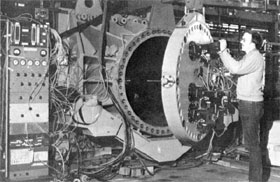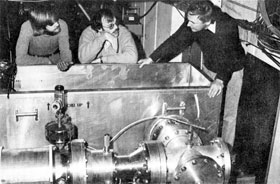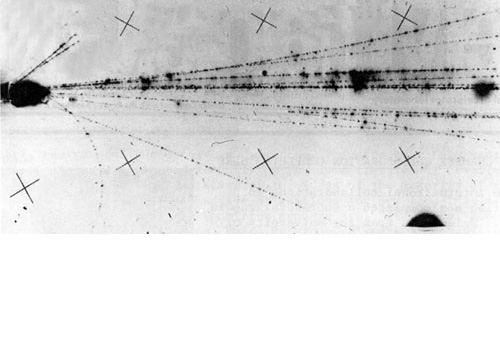First Streamer Chamber Collaboration Completed Here
One of the international collaborations so common at Fermilab has completed a successful run in the Meson Area. Scientists from the University of Washington at Seattle, the University of California at Davis, and the Laboratoire de l'Accelerateur Lineaire at Orsay, France came together in the Midwestern United States, bringing with them years of collaboration and joint studies. They recently completed two of the first streamer chamber experiments at Fermilab energies, E-416 and E-86.
The experimenters included T. Burnett, V. Cook, S. Csorna, A. Jonckheere, R. Kenyon, H. J. Lubatti, K. Moriyasu, and B. Robinson of the University of Washington; J. Klems, W. Ko, R. Lander, D. Pellett, of the University of California, Davis; J. Colas, D. Fournier, P. Rancon, and J. J. Veillet of the Laboratoire de l'Accelerateur Lineaire, Orsay. The late Prof. A. Lagarrigue of Orsay did much to make the collaboration possible.
The same magnet that is such an important part of the experiment had previously served the experimenters at CERN, in Geneva, Switzerland, from 1961 to 1964. It was at Orsay that the present collaborators first became interested in doing an experiment to study the diffractive dissociation of particles. In 1970 they submitted a proposal to continue at Fermilab the research they had begun in Europe. The French scientists also furnished the cameras for the experimental apparatus. The California experimenters on E-416 furnished the scintillators for the muon telescope and a calorimeter. The University of Washington provided the experiment's other hardware.
One of the international collaborations so common at Fermilab has completed a successful run in the Meson Area. Scientists from the University of Washington at Seattle, the University of California at Davis, and the Laboratoire de l'Accelerateur Lineaire at Orsay, France came together in the Midwestern United States, bringing with them years of collaboration and joint studies. They recently completed two of the first streamer chamber experiments at Fermilab energies, E-416 and E-86.
The experimenters included T. Burnett, V. Cook, S. Csorna, A. Jonckheere, R. Kenyon, H. J. Lubatti, K. Moriyasu, and B. Robinson of the University of Washington; J. Klems, W. Ko, R. Lander, D. Pellett, of the University of California, Davis; J. Colas, D. Fournier, P. Rancon, and J. J. Veillet of the Laboratoire de l'Accelerateur Lineaire, Orsay. The late Prof. A. Lagarrigue of Orsay did much to make the collaboration possible.
The same magnet that is such an important part of the experiment had previously served the experimenters at CERN, in Geneva, Switzerland, from 1961 to 1964. It was at Orsay that the present collaborators first became interested in doing an experiment to study the diffractive dissociation of particles. In 1970 they submitted a proposal to continue at Fermilab the research they had begun in Europe. The French scientists also furnished the cameras for the experimental apparatus. The California experimenters on E-416 furnished the scintillators for the muon telescope and a calorimeter. The University of Washington provided the experiment's other hardware.
The experiments use the first streamer chamber in a major experiment at Fermilab. The streamer chamber, a vessel 1m x 50 cm x 30 cm (about the size of a trunk) is filled with neon gas, then mounted inside the magnet. A beam of particles comes through the beam pipe of the M-l beam line. For E-416 a 5 cm lucite target was placed at the upstream end of the streamer chamber. A carefully-calculated combination of electronic devices ignores unwanted events but permits up to five cameras with shutters continually open, to be triggered by "good" events visible through the glass side of the streamer chamber. A good event results in a picture similar to a bubble chamber track picture. The film is analyzed on automatic scanning devices at both the University of Washington and at Orsay, France.
E-416 searched for "charmed" particles by looking in the streamer chamber for neutral strange particles produced in association with muons. "Charm" may be a property similar to strangeness. Charm has received a great deal of attention since the discoveries in the neutrino beam at Fermilab and the discovery of the J/psi. Theorists at Fermilab and elsewhere have suggested that charmed particles would occasionally decay into a muon plus a strange particle and a neutrino. To see this decay, a large muon detector, consisting of magnetized iron absorber, provided by Fermilab, plus scintillators and spark chambers, was placed behind the streamer chamber to signal whenever a muon was produced. A picture was then taken of that interaction in the streamer chamber.
The streamer chamber pictures were scanned and the number of "Vees" (neutral strange particles look like the letter V in a streamer chamber) associated with muons were counted. This number was compared with the number of Vees ordinarily produced without a muon. Any excess of the Vee-plus-muons events could be an indication of possible charmed particles.
"Charm, unfortunately, turned out to be even more elusive than we thought," reports Henry Lubatti of the University of Washington, spokesman for E-416. "We did not find any excess in the number of Vees produced with muons over that ordinarily produced without muons."
The experiment, however, did see a handful of psi/J events, and they have submitted a proposal to use their streamer chamber to further study the details of how psis are produced, still unknown to particle physicists.
E-416's search for charm was a diversion from E-86, which studied the diffractive dissociation of pions on helium nucleus targets. For E-86 the streamer chamber was filled with helium gas which acted as the target and also produced streamers for the charged tracks. The sensitivity of this experiment can be inferred from the fact that bags of helium gas are often used in experiments as a cheap substitute for vacuum pipes! The experimenters returned to E-86 after the charm search and these data are now being analyzed.
"E-86 and E-416 have demonstrated how streamer chambers can effectively bridge the gap between bubble chambers and pure electronic detectors," Dr. Lubatti says. "Streamer chambers can operate with high intensity beams and can be triggered like counter experiments. Thus, they are uniquely suited for detecting very rare events and showing every charged particle, as well as many neutral particles, from the interactions."






